The Roman empire may have fallen but many examples of their architecture and sculpture remain. The United States of America, a living and breathing nation, has many architectural and sculptural examples in its capital of Washington D.C. There are many similarities between the way Romans and Americans created art; similarities of style and form, similarities in statuary, and similarities in the symbolism within. There are as many differences between them as well. Looking at the art of these two powerful nations will shed light on some of the similarities and differences between them.
Looking first at style and form in architecture, the Pantheon in the Roman capital city of Rome, one of the more iconic buildings in the world, comes foremost to mind. Copied for centuries by architects the world over, it was the inspiration that blossomed into the Thomas Jefferson Memorial in Washington D.C. nearly two thousand years after the Pantheon’s creation. Both feature domed roofs and drum-like supporting walls. The Pantheon was originally on a pedestal but the surrounding land has crept up and access to the Pantheon is now at street level. The Jefferson Memorial is also elevated by a series of steps. Pillars support the triangular pediment of both buildings, though the Pantheon has three rows of pillars, eight across the front and two rows of four behind, while the Memorial has two rows, eight in front and four in back. The D.C. Monument also has 26 columns surrounding the “drum” of the building and four more at each of the monument’s entrances while the Pantheon’s drum is free from adornment. Aside from the aforementioned differences, there are a few others as well. The Pantheon’s dome features an opening at its apex, called the oculus, which is open to the elements while the building itself is not. The memorial, on the other hand, features a solid dome but the building itself is open to the elements. The Pantheon’s spheric interior is not repeated in the memorial nor is its grand scope. The two buildings, one inspiring the creation of the other, have many similarities and as many differences.
Moving from buildings to statues, specifically statues crafted to represent and honor specific real people, we find more similarities than differences between Roman and American statuary. Roman statues were lifelike, accurately representing the human form, often recognizably the person they were supposed to be. Augustus of Primaporta, c. 20 B.C. and the bust of Cicero, 1st century B.C. both show “the Roman era’s keen interest in realism” (Bishop 83). The statue of Abraham Lincoln featured in the Lincoln Memorial and the equestrian statue of Ulysses S. Grant are also very realistic (if larger than life) and excellent portrayals of realism. Augustus of Primaporta, the bust of Cicero, and the statue of Lincoln were all sculpted from marble and Grant from bronze. The Romans did create sculptures from bronze but as a more reusable medium than marble, fewer have survived to be studied by modern peoples. The above American statues were created to honor men who had lived and served their country. The Roman statues, on the other hand, were created during the lifetime of their subjects. This is an important difference between Roman and American statuary of real people. There are similarities and differences, as well, in why Roman and American artists created sculpture and architecture the way they did.
Comparing the Column of Trajan with the Washington Monument reveals much about what motivated the two cultures to erect stone sculptures in their capital cities. The Column of Trajan was designed by Apollodorus but was commissioned by the Roman Senate (wikipedia) and was constructed during Trajan’s lifetime,
between 106-13 (Bishop 75). The Column features a spiral of sculptural pictures which tell an uninterrupted story – that of Trajan’s conquest over the rebelling Dacian forces. It served as a powerful propaganda tool for “the gold from Dacian mines funded public welfare and imperial construction during Trajan’s reign” (Bishop 77). The Washington Monument, while much larger in scale (over 555 feet tall to the Column’s 125 feet including the pedestal) (National Park Service), is perhaps more modest in motive. The monument was built almost 100 years after the life of George Washington, the first President of the United States, had ended. It was built not to glorify a living god-man but to honor the memory of a good man. The Column of Trajan’s pictorial sculptures showcase the suppression of rebel forces. The Washington Monument memorializes the victorious rebel general. The Roman emperor was believed to be a god and, just as lavish and opulent cathedrals are built “for” god(s), so buildings and monuments were built “for” the emperor. American leaders, on the other hand, having been chosen by the people, are seen as a reflection of the people and, as such, are honored, not for their status as “gods” but for the characteristics that Americans like to imagine themselves as having – independent, self-sufficient, freedom-loving. Perhaps, there are not so many differences after all. The Roman emperors built to honor themselves as gods and the American people build to honor themselves through the men they have chosen to lead them and the ideals they espouse to have.
The dreams of the Roman leaders – to bring the entire world under Roman rule – largely remained unfulfilled but their architecture and sculpture lives on. Only time will tell if the American dream of life, liberty and the pursuit of happiness for all will come to fruition or not and only time will tell if America’s contributions to architecture and sculpture will be as lasting. As shown, there are many similarities between the two cultures’ architecture and sculptures and there are many differences. There are not, however, as many differences as might be expected for two cultures separated by nearly 2000 years.
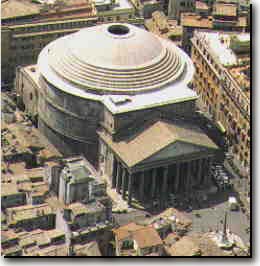
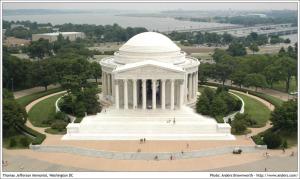
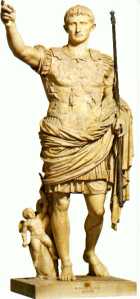

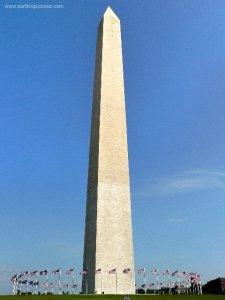
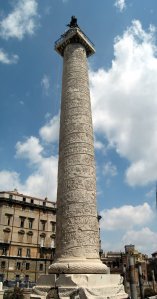

Not being American I had not seen the Jefferson Memorial before. It is very much Roman. Another similarity between Roman and American is philosophy, the article hinted at but never said “… to bring the entire world under Roman rule” this is a belief the Americans also have, thinking they should/do rule the world.